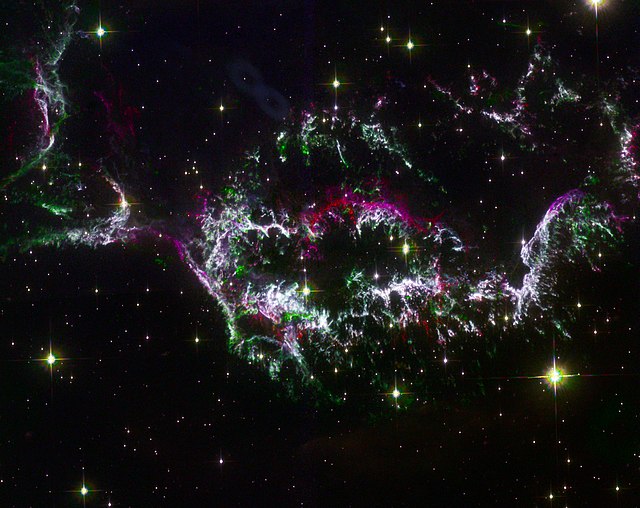 The James Webb Space Telescope captures stunning details of the massive cosmic explosion of the Green Giant. Credit: Joxeankoret / Wikimedia Commons / CC BY-SA 4.0
The James Webb Space Telescope captures stunning details of the massive cosmic explosion of the Green Giant. Credit: Joxeankoret / Wikimedia Commons / CC BY-SA 4.0A stunning picture from a space telescope called the James Webb Space Telescope (JWST) has been released. The picture shows a huge cloud of debris that was made by the explosion of a star, which is called a supernova.
The supernova happened about 340 years ago from where we are on Earth. The explosion made a cloud of wreckage that is 10 light years wide, and it’s called Cassiopeia A (Cas A). This is one of the newest supernova clouds that we know about.
By studying pictures like this, scientists can learn more about what happens when stars die, which is important because it helps us understand the universe.
The stuff that is left over after a supernova, like the Cas A cloud, goes out into space and gets mixed up with other stuff. This stuff helps make new stars and planets. This happened a long time ago when the sun and the planets in our own solar system were made. It also gave us the things we need to live, like calcium and iron.
Formation of Cas A in Constellation Cassiopeia
A group of space scientists has been studying a thing called Cas A. This is a huge debris field in space that was made when a star exploded a really long time ago. It’s located in a part of the sky called the constellation Cassiopeia, and it’s 11,000 light-years away from us.
Scientists want to understand what kind of star was there before it exploded and how the explosion happened. They have used telescopes on the ground and in space to look at Cas A before, but the new picture from the James Webb Space Telescope is the clearest one they’ve seen.
Danny Milisavljevic, an Assistant Professor at Purdue University and principal investigator of the Webb program said, “Cas A represents our best opportunity to look at the debris field of an exploded star and run a kind of stellar autopsy to understand what type of star was there beforehand and how that star exploded.”
The new picture is really colorful, but it doesn’t just look beautiful. The colors actually tell the scientists a lot of information about what’s happening in Cas A. They are just starting to learn from this new information.
What Does the New Image Reveal?
The new picture from the James Webb Space Telescope shows a lot of interesting things. At the top of the picture, there are orange and red colors. These colors show where material from the exploded star has been pushed out into space and is now heating up and making light.
Stars: always making a dramatic exit! 🌟
Webb’s powerful infrared eye has captured never-before-seen detail of Cassiopeia A (Cas A). 11,000 light-years away, it is the remnant of a massive star that exploded about 340 years ago: https://t.co/LLQsFQJwVQ pic.twitter.com/xqlGFzhYoy
— NASA Webb Telescope (@NASAWebb) April 7, 2023
In the middle of the picture, there are pink clumps. These are made of material from the star that exploded. The clumps are making light by using heavy elements like oxygen, neon, and argon that the star made before it blew up.

 1 year ago
63
1 year ago
63











 English (US)
English (US)